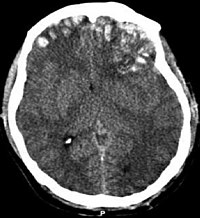
Photo from wikipedia
Background Previous studies have demonstrated that statins can relieve inflammatory brain injury after intracerebral hemorrhage (ICH), but the mechanisms remain poorly characterized. This study aims to test whether simvastatin exerts… Click to show full abstract
Background Previous studies have demonstrated that statins can relieve inflammatory brain injury after intracerebral hemorrhage (ICH), but the mechanisms remain poorly characterized. This study aims to test whether simvastatin exerts an anti-inflammatory effect by regulating the pro-resolving mediators. Methods First, male Sprague–Dawley rats had an injection of 200 μL autologous blood. Then, rats were randomly divided into groups treated with simvastatin (i.p. 2 mg/kg) or vehicle. Next, all rats underwent pro-resolving mediator lipoxin A4 (LXA4) level detection, flow cytometric, immunofluorescence, brain edema measurement, neurological scoring and western blot analysis. Results We found that simvastatin significantly increased the plasma level of LXA4, an endogenous formyl-peptide receptor 2 (FPR2) agonist, in the early stage of ICH. Consistent with the effect of simvastatin, exogenous LXA4 administration also promoted apoptosis of the circulating neutrophils, reduced neutrophils brain infiltration, and ameliorated inflammatory brain injury after ICH. In addition, similar to simvastatin, exogenous LXA4 markedly decreased the level of phosphorylated p38 mitogen-activated protein kinase (MAPK) and the apoptosis-related proteins myeloid cell leukemia 1(Mcl-1)/Bax ratio (a decreased ratio represents the induction of apoptosis) in circulating neutrophils isolated from ICH rats. Notably, all of the aforementioned effects of simvastatin on ICH were significantly abolished by Boc-2, a selective antagonist of FPR2. Moreover, simvastatin led to a similar Mcl-1/Bax ratio reduction as SB203580 (a p38 MAPK inhibitor), but it was abolished by P79350 (a p38 MAPK agonist). Conclusion Collectively, these results suggest that simvastatin ameliorates ICH-mediated inflammatory brain injury, possibly by upregulating the level of pro-resolving mediator LXA4 and further stimulating the FPR2/p38 MAPK signaling pathway.
Journal Title: Current Neurovascular Research
Year Published: 2022
Link to full text (if available)
Share on Social Media: Sign Up to like & get
recommendations!